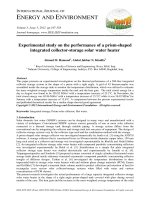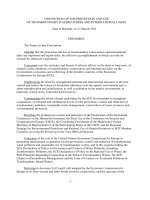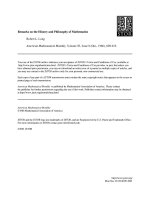Experimental study on the failure and deformation of beam column joints under seismic loads
Bạn đang xem bản rút gọn của tài liệu. Xem và tải ngay bản đầy đủ của tài liệu tại đây (1.84 MB, 8 trang )
RESEARCH RESULTS AND APPLICATIONS
EXPERIMENTAL STUDY ON THE FAILURE AND
DEFORMATION OF BEAM-COLUMN JOINTS UNDER
SEISMIC LOADS
Nguyen Le Ninh1, Vo Manh Tung2*
Abstract: Beam-column joints play an important role, affecting the earthquake response of reinforced concrete (RC) frames. Their behavior is influenced by the way in which they damage the beams, columns and
the complex interaction between the shear, bonding and confined mechanisms in a limited zone. To clarify the
force-bearing and deformation of the joints that are being designed under earthquake loading and will be available in Vietnam, experimental studies are conducted in 1:1 scale specimens. This paper introduces the results
of experimental research on the failure and deformation of the joints, as well as the causes of these behaviors.
Keywords: Beam-column joint, seismic experiments, earthquake, reinforced concrete (RC).
Received: October 10th, 2017; revised: October 30th,2017; accepted: November 2nd, 2017
1. Introduction
The behavior of reinforced concrete (RC) moment resisting frame structures in recent earthquakes
all over the world has highlighted the consequences of poor performance of beam-column (BC) joints. The
BC joints are crucial zones for the transfer of loads effectively between the connecting elements (i.e. beams
and columns) in the structures [1-4]. Shear failure of reinforced concrete BC joints has been recognized as
an undesirable mode of failure, which lowers the seismic resistance of RC moment frame structures. The
large amount of research carried out to understand the complex mechanisms and safe behavior of BC joints
has gone into code recommendations. But it is worth mentioning that the relevant research outcomes on BC
joints from different countries have led to conflicts in certain aspects of design [5,6]. The seismic provisions
in major concrete codes, such as ACI, EC8, NZS, TCVN 9386:2012 .., the shear failure of BC joints is prevented. If the frame is designed to have weak beam-strong column mechanism, then the lateral strength of
the frame could be calculated based on the flexural strength of beam sections. To achieve this goal, capacity
design does not allow the premature joint shear failure before the beam yielding.
In this circumstance, the theoretical and experimental studies on the strength and ductility of the BC
joints of RC frame under seismic loading are necessary to be carried out. The obtained results will be used
to find out the failure modes, the ductility, the loading capacity, the stiffness as well as the energy dissipation
of the seismic resistance joints based on the previous and modern design. Besides, the factors that influence
the mentioned properties of the RC joints are given.
In the followings, the experimental studies on the failure and deformation of several RC joints, implemented in the IBST Seismic Lab, are going to be presented.
2. Details of Specimens
To investigate the joint performance (strength, deformation, ductility and energy dissipation), a series
of three plane-frame interior BC joint test units are designed. The full-scale specimens are extracted from a
frame of a 3-storey RC building. The building is designed with respect to seismic codes TCVN 9386: 2012
[7] and SP 14.13330.2014 [8]. The BC Joint test specimens are named as below:
- Specimen NK1: designed according to TCVN 9386:2012 [7].
- Specimen NK2: calculated according to the TCVN 9386:2012 (seismic actions only) and detailed
according to the TCVN 5574:2012 [9].
Asso.Prof.Dr, Faculty of Building and Industrial Construction. National University of Civil Engineering.
Msc, Faculty of Building and Industrial Construction. National University of Civil Engineering.
* Corresponding author. E-mail:
1
2
JOURNAL OF SCIENCE AND TECHNOLOGY IN CIVIL ENGINEERING
Vol. 11 No. 6
11 - 2017
5
RESEARCH RESULTS AND APPLICATIONS
- Specimen NK3: designed according to the SP 14.13330.2014 [8].
All test specimens have same sizes (cross sections and lengths). Dimensions and details of specimens are described in Fig. 1 and Table 1. Material properties of the specimens are given in Table 2 and 3.
The test specimens were cast in The Laboratory of Construction Testing and Inspection-National University
of Civil Engineering.
Figure 1. Details of specimens
3. Loading procedure and instrumentation
Figs. 2a and b show the overall test set-up. The test specimens were supported in a vertical position
with a pin at the bottom of the column and free to move at the column top in horizontal direction either ways.
An axial load of 300 kN was exerted on the top of the column with a heavy duty hydraulic jack. The both
beam ends were supported by horizontal rollers.
A cyclic horizontal load is applied at the column top of the test specimens. The selected load is
intended to cause forces that simulate high levels of inelastic deformations of the frames during a severe
earthquake ground motion. The selected load routine shown in Fig. 3, consists of two stages. The first stage
is load-controlled followed by displacement-controlled loading stage. In the load-controlled stage, two first
cycle 1-2, test specimens were loaded in the lateral direction V = 0.75Vi = 0.75 × 59.23 = 45 kN, where Vi:
the theoretical load capacity of the specimen under lateral and vertical loads, determined from the their
dimensions and material properties. The purposes of this load cycle were to determine the yielding displacement ∆y and the actual stiffness Ktn of the test specimens. After the two initial elastic cycles, inelastic cycles
Table 1. Technical parameters of specimens
Specimens
NK1
NK2
NK3
Longitudinal reinforcement of beams As=A’s (Class AII)
3Φ16
3Φ16
3Φ16
Reinforcement ratio of beams ρd
0.52%
0.52%
0.52%
Reinforcement ratio of columns (Class AII)
8Φ16
4Φ16
4Ф18
The reinforcement ratio of columns ρc
1.48%
0.74%
0.94%
Beam stirrup ρđd (Class AI)
Φ6a125; a240
Φ6a140; a270
Φ6a140; a270
Beam stirrup ratio
0.18%;0.09%
0.16%;0.08%
0.16%;0.08%
Column stirrup ρđc (Class AI)
Φ6a75, a177,
Φ6a100, a187
Φ6a160, a240
Φ6a160, a240
Column stirrup ratio
0.37%;0.16%
0.28%;0.15%
0.1%;0.07%
0.1%;0.07%
Stirrup in the joint ρđn
6Φ6a75(D1);
6Φ6a75(D2)
3Φ6a160
3Φ6a160
0.37%
0.1%
0.1%
Stirrup ratio in the joint
6
Vol. 11 No. 6
11 - 2017
JOURNAL OF SCIENCE AND TECHNOLOGY IN CIVIL ENGINEERING
RESEARCH RESULTS AND APPLICATIONS
Table 2. Material properties of concrete and reinforcement
Concrete
Specimen
fc at 28-day age (MPa)
Age of Specimen at the tested time (day)
Reinforcement
NK1
NK2
NK3
30
29
31
fy (MPa)
Ф18
Ф16
Ф6
310
320
235
510
400
83
90
80
fu (MPa)
480
31.5
32
31.7
Es (MPa)
2.1×105
εc
0.0025
0.0025
0.0025
Ec (MPa)
30000
30000
30000
fc at the tested time (MPa)
were applied at progressively larger displacement ductility factors, with four full cycles being imposed on
each level of ductility. The object of progressively increasing the ductility demand on the structure was to
define as closely as possible the ductility demand at which the failure in the unit might occur, and to observe
the behavior both before and after any such failure. The intermediate cycles to displacement ductility factor
µ∆=0,75 were included on the basis that cyclic behavior under actual seismic attack would not consist merely
of increasingly larger post-elastic cycles. The tests were to be continued since the specimens had lost 20%
load-bearing capacity to find out the maximum plastic deformation and the main factor that caused the failure
and the loss of the load-bearing capacity.
The instrumentation of the test specimens was designed to measure the overall response and the
load resistance mechanism in the beam-column subassemblage. Three types of measuring device were
used: load cell, LVDTs (Linear Variable Differential Transformers) and strain gauges. The test data were
obtained at every load step in loading and unloading cycles and the reverse direction of loads, including
lateral induced loads, displacements of column ends, shear deformation in the joint area, flexural and shear
deformation of beams, columns and deformation of reinforcement in the critical zones of beams, column and
joint... The locations of LVDT and strain gauges were displayed in Figs. 4 and 5.
4. The failure of specimens and the causes
4.1 The failure of specimens
4.1.1 Test specimen NK1
Specimen NK1 was designed according to the TCVN 9386:2012[7], that secured the rules of the
ductile failure of the RC frame: the hinges were formed in beams first, the shear failure happened after the
Figure 2. Schematic of test set - up
Figure 3. Load routine
Figure 4. LVDTs for joint shear deformation and for beams
shear and flexural deformation
JOURNAL OF SCIENCE AND TECHNOLOGY IN CIVIL ENGINEERING
Vol. 11 No. 6
11 - 2017
7
RESEARCH RESULTS AND APPLICATIONS
Figure 5. The locations of LVDT to obtain the rotational displacement of beam and column ends
And the position of strain gauges
occurrence flexural failure and the joint was failed at last. With
the design rules, the ratio of the yielding moment of the beam
to that of the column of NK1: Myi,c/Myi,d = 1.29. The final crack
pattern is shown in Fig. 6 at the end of 19th loading cycle.
The images of the crack pattern show that:
- The beams were damaged with the cracks nearly or
perpendicular to their axes. These cracks were uniformly distributed in a length of 2hd (hd=the height of the cross-section of the
beams). When the load reversed, the cracks were connected to
form continuous cracks running through the height of the beams.
Figure 6. NK1 specimen image at end of
experiment - 19th cycle
- At the column areas around the joint, the cracks are
also appearing. These flexural cracks nearly or perpendicular
to the column axes were on both sides of the columns in the
similar distance to the joint due to the reversal action of loading.
In comparison with beams, the column cracks were smaller in
both the number and the width and located on the length about
1.5hc (hc -the height of the cross-section of the column).
- At the joint, there was a net of inclined cracks parallel to
the diagonal line of the panel joint. The distance between cracks Figure 7. Specimen image of NK2 at end of
was approximate equal. Under the effect of the reversal action
experiment - 17th cycle
of loading, the cracks divided the joint area as a canarium net.
4.1.2 Test specimen NK2
Specimen NK2 was calculated according to TCVN
9386:2012 for seismic actions and detailed according the concrete design code TCVN 5574:2012 [9]. The moment ratio
Myi,c/Myi,d = 1.02. The stirrups in the joint were similar as those
in the vicinity area of the columns with the reinforcement ratio
ρwn = 0.1%. In this case, the risks of shear-flexural failure of
column, beam and the joint were equal. The final crack pattern
at the end of 17th loading period is shown in Fig. 6. The image Figure 8. NK3 specimen image at end of
experiment - 14th cycle
of pattern cracks showed that the failure occurred in the joint
region and its surrounding areas. This pattern cracks were very different with that at NK1:
- In comparison with NK1, flexural cracks of the beams were smaller in number and appeared in a
shorter length (about 1.5hd). Most of the cracks were not long enough to connect to the crack on the opposite
side to run through the whole section of beams.
- The flexural cracks of the upper and lower columns were small in number and their width were also
very narrow. The cracks had not widened in the loading process.
- At four corners of the BC joint, there were many cracks perpendicular and parallel to the diagonal direction. The cracks intersected and formed diamond shaped panes adjacent to the beams’ end. The cracks did
not run into the central area of the joint. Thus, the considerable canarium shaped area in the joint seemed not to
be cracked. The area inside the boundary of the joint was cracked, seriously to form two broken strips along with
the longitudinal reinforcement of columns. The strips ran through the joint to the vicinity areas of the columns.
8
Vol. 11 No. 6
11 - 2017
JOURNAL OF SCIENCE AND TECHNOLOGY IN CIVIL ENGINEERING
RESEARCH RESULTS AND APPLICATIONS
4.1.3 Test specimen NK3
Test specimen NK3 was designed and detailed according to the current Russian seimic design code
SP14.13330-2014 [8]. The moment ratio Myi,c/Myi,d was 1.12. The final crack pattern of this test specimen is
shown in Fig. 8 at the end of 14th loading cycle. The crack pattern of NK3 and NK2 were quite similar to that
of NK1, but the some differences are as follows:
- In the joint region of NK3, the inclined cracks in both directions developed in the central zone. Thus,
the uncracked rhombic shaped area of the joint region of the NK3 was smaller than that of NK2. Although
the inclined cracks were mainly formed in the vicinity areas of the beam ends, there was no splitting strips at
the vertical sides of the joint region in NK3 that occurred in NK2.
- The cracks in the beams and columns around the joint region of NK3 are more numerous and wider than
the NK2. At the two ends of the beam, many inclined cracks appear in the upper and lower beams as in the NK2.
4.2 The causes of the failure
The joint core is subjected to two types of actions
that combined are generally known as joint shear [6]:
- Concrete flexural compression from beams and
columns at the opposite corner of the joint (Fig. 9b);
The shear flow along its perimeter from beam and
column bars by means of bond forces (Fig. 9c).
The resistance mechanism is composed by a compressed concrete diagonal strut roughly limited by the neutral axes of the end sections of the members (Fig. 9d) and
by diagonal compression field-truss mechanism-consisting
of horizontal hoops, intermediate column bars and inclined
compressed concrete strips between shear cracks (Fig. 9e).
Thus, failure of the joint is due to the inability of any
of the "sub-mechanisms" depicted in Figs. 9d, e and f to car- Figure 9. The force transmission and bearing
mechanisms in the joint
ry successfully the load they are meant to sustain. It follows
then that three different sources for joint failure can be pointed out: failure of the compressed diagonal strut, failure due to loss of bond resistance along the joint boundary and failure due to inability to develop a truss mechanism that can carry the diagonal tension by the premature yielding of the longitudinal bars intercepting the core.
The failures of the specimens NK2 and NK3 has not been documented in the specialist literature before, which is a combination of the three sources of the joint failure above. Based on the force transmission
and bearing mechanisms in the joint region mentioned above, the cause of the failure of the joint is as follows:
a) The mobilization of the truss mechanism is subject to the shear force depends on the bond of the
reinforcement in the joint region. In order to prevent early damage to the bond under two-way effects, the
concrete core confined is an extremely important factor. The confined effect is generated through the stirrup
and intermediate reinforcement columns. The specimen NK1 has a much larger concrete confined effect
than the other two. This is evidenced by the analysis of the rotational displacement data for the beams,
columns and yield strain of the reinforcements of the three specimens.
The relationship of the storey shear V-lateral displacement Δ of the samples shown in Figs. 10a, b
and c shows the hysteresis loop of all three specimens in a two-directional load of approximately symmetrically. All of the hysteresis loops exhibit a pinching to varying degrees in the specimens. The specimen NK1
has the pinching level smallest and the shortest, while the NK3 is the narrowest. This pinching effect begins
to appear when the ductility µΔ is = 2 in NK1, while NK2 and NK3 appear earlier in the µΔ = 1.5. The cause
of the pinching of the loops is the slip and the yield of the beam longitudinal bars. This indicates that the
longitudinal bars of the beams on the NK2 and NK3 specimens lost bond earlier and had a larger slip.
- Deformation of the beams
Figs. 11a, b and c show the relationship between the bending moment and the rotation of the beam
section at 50 mm from the right column face. These graphs show that, at the final load cycles before the end
of the experiment, the rotational displacement of the beams of the NK1 specimen has a very large increase
JOURNAL OF SCIENCE AND TECHNOLOGY IN CIVIL ENGINEERING
Vol. 11 No. 6
11 - 2017
9
RESEARCH RESULTS AND APPLICATIONS
(Fig 11a). The cause is the effect of concrete confined has made the longitudinal bar the beam through the
joint of NK1 hold tight, no loss of bond and no slip so it can develop yield deformation, fully, while in NK2
and NK3, longitudinal bar can not develop full deformation due to premature adhesion loss and slip. The
strain gauges on beam reinforcements show that in NK1 the longitudinal bar the beam starts to yield in the
3rd cycle at the column face, particularly in the near to center column is not yielding or yielding later in the
9th cycle (negative), 11th (positive), while in NK2 and NK3 specimens the longitudinal bar the beam begins
to yield at the 3rd cycle at the column face, but at the near to column center is yielding soon at 3rd, 6th cycle
of NK2 and 3rd, 5th cycle of NK3.
Figure 10. The relationship of the storey shear V- lateral displacement Δ
- Deformation of the columns.
The strain gauges mounted on the column reinforcement shows that the reinforcement on the right
side of the NK1 column face starts to yield in the 8th cycle, particularly at the center of the beam of the 12th
cycle, while the NK2 and NK3 begin to yield relatively early in 5th cycle, at the center beam is not yielding.
This proves that the NK1 column reinforcement has developed a good plastic deformation, while in NK2 and
NK3 specimens, only plastic deformation at the beam face sections of the column.
This behavior of the column reinforcement in the joint has been reflected in the curves in Fig. 12. In the
NK1 specimen, the rotational displacement θc of the column is small and almost linearly stable until the column reinforcement at the horizontal cross-section of beam face beginning to yield at level μΔ = 3 (8th cycle).
Then, the rotation increases nonlinearly but is much smaller than the other two. For the NK2 and
NK3 specimens, until the column reinforcement at the horizontal cross-section of the beam face is yield at
level μΔ = 2 (5th cycle), the rotation of the column is the same as that of the specimen NK1, then nonlinear
increase. Thus, column reinforcements in NK2 and NK3 can not develop the full plastic deformation as in
NK1. This shows that the rotational displacement of the columns in the NK2 and NK3 specimens is not a
complete plastic displacement as in the NK1 but rather a composite of yielding reinforcement, compression
and tensile of concrete and reinforcement elongation is similar to the case of beam deformation.
Figure 11. The relationship between the bending moment and the rotation of the beam section at 50 mm
from the right column face
Thus, it can be seen that the NK1 specimen is capable of taking form the truss mechanism while the
NK2 and NK3 do not have this capability. The diagonal cracks of the NK2 and NK3 specimens cannot be
formed, instead they are still compressed at corners due to the rotational displacement at the ends of the
beams and columns (Figs. 7 and 8).
b) As the inelastic loading cycles increase, the role of the compression strut (Fig. 9d) decreases and
increases the contribution of the truss mechanism (Fig. 9e) to the transmission of the horizontal shear force.
Until the 4th cycle, the cracks images of all three specimens are very similar, indicating the same behavior
that is the compressive behavior of the beams and columns on the joint at the first inelastic cycles, before
10
Vol. 11 No. 6
11 - 2017
JOURNAL OF SCIENCE AND TECHNOLOGY IN CIVIL ENGINEERING
RESEARCH RESULTS AND APPLICATIONS
starting to mobilize the truss mechanism. As the load
cycles increase in the inelastic region, the NK1 joint is
stressed to a smaller degree, by the beams and then
the column is deformed plastic bending, while the NK2
and NK3 joints are subject to increased local compression from the large rotates of beams and columns due
to the loss bond of reinforcement and the weakened
confined concrete that is not capable of transmitting the
diagonal force into the core of the joint.
c) The spalling of concrete along the column reinforcement on either side of the NK2 specimen (Fig. 7)
is a combination of three effects: crack expansion at the Figure 12. Locations LVDT installed in diagonal
contact section between beam and column due to the
beam is rotated when the reinforced beam is yield and losses bond, the corners of the panel joint are compressed local by the column rotation and especially the beam around, buckling out due to the loss bond and
the distance of stirrups too large not enough to create the effect confined of column reinforcement.
5. Shear deformation of joints
Shear deformation in the joint provides a measure of joint stiffness. The two LVDTs placed diagonally
across the corners of the joint panel measured the elongation and shortening of the diagonals with load (see
Figs. 4a and 12). The average shear deformation of the joint panel was computed by the equation:
(1)
where Δ1 and Δ2 are the change in the lengths of the diagonals, D is the length of the diagonal (distance
between LVDT ends) and θ is the angle between the diagonal and the horizontal member. The story shear V
versus joint shear deformation γ for three specimens are shown in Figs. 13a, b and c. These figures show that
the joint shear deformation of specimen NK1 is very low compared with that of specimens NK2 and NK3. Figs.
13b and c show that the joint deformations of the specimens NK2 and NK3 are very low in the first two loading
cycles, but after that the excessive shear deformation and stiffness degradation in the joint are occurring.
The relationship between the joint shear deformation γ and the displacement ductility μΔ given in
Fig. 13d, shows a very large variation in the magnitude of the joint shear deformation designed in different
ways. The NK1 joint is designed according to a modern design standard, attaching importance to ensuring
the stiffness, durability and ductility of the joint, other than NK2 and NK3, stirrup as in the adjacent columns
only. The joint shear deformation of these two specimens was more nonlinear than the NK1. Particularly for
NK2 and NK3 specimens, the only difference is the diameter of the longitudinal bars of column, which makes
the ratio of ultimate bending strength of the column and beam in NK2 with Myi,c/Myi,d = 1.02 and NK3 by
Myi,c/Myi,d = 1.12. Thus, the increase Myi,c/Myi,d ratio in NK3 appears to be a condition that increases the joint
shear deformation when not properly confined.
Figure 13. Storey shear - Shear deformation joint, The relationship between shear deformation joint γ - ductility µ∆
JOURNAL OF SCIENCE AND TECHNOLOGY IN CIVIL ENGINEERING
Vol. 11 No. 6
11 - 2017
11
RESEARCH RESULTS AND APPLICATIONS
6. Conclusions and recommendations
Based on the analysis of the failure modes of the test specimens and the joint shear deformation, the
following conclusions may be drawn:
- Different design methods lead to different behavior of the specimens. The NK1 pattern failure is
ductile with hinges occurring in the beams near the column face. Damage to the joint and its deformation is
relatively evenly distributed over the entire joint panel. The failure mode of NK2 and NK3 specimens is brittle.
The joint panel of this specimen is crushed under the local compression, impact of the column and beam
rotation, the beams and columns are not fully deformed plasticity and are not completely bending. The risk
of failure (bending and shear) between the beams, columns and joints is nearly equal.
- Under the shear and bending of beams and columns, joints will be significantly deformed, even
when designed in accordance to the modern seismic code (TCVN 9386:2012). Therefore, considering the
deformation of the BC joint in the seismic design of moment resisting reinforced concrete frame system is
very necessary.
- The experiment shows a tremendous importance of concrete confinement as recommended by
most international codes. To prevent shear failure of the BC joints, both horizontal and vertical reinforcement
are required. Confinement may be achieved with reinforcement that can exert clamping action across splitting cracks. Therefore, intermediate column bars, apart from their role as vertical joint shear reinforcement,
are very important to prevent premature bond failure in the joint.
- Experiment shows that frame structures are designed in accordance to the Russian seismic standard SP 14.13330.2014 and Vietnam concrete code TCVN 5574:2012 are not suitable for developing a
ductile failure mechanism in strong ground motions.
Acknowledgement
The authors would like to express grateful thanks to the colleagues in the Laboratory of Construction Testing
and Inspection (NUCE) and the Seismic Laboratory (IBST) for their help.
References
1. Beckingsale C.W., (1980), Post-Elastic Behavior of Reinforced Concrete Beam-Column Joints, Research
Report 80-20, Department of Civil Engineering, University of Canterbury, Christchurch, New Zealand.
2. Ninh N.L. (2007), Earthquake and earthquake resistant structure design, Construction Publishing House
(in Vietnamese).
3. Paulay T., Priestley M.J.N., (1992), Seismic design of reinforced concrete and masonry buildings, John
Wiley, USA.
4. Sangjoon P., Khalid M.M., (2012), Experimental and Analytical Studies on Reinforced Concrete Buildings
with Seismically Vulnerable Beam-Column Joints, PEER Report 2012/03, Pacific Earthquake Engineering
Research Center, USA.
5. Kim J., LaFave J.M., (2009), Joint Shear Behavior of Reinforced Concrete Beam-Column Connections
subjected to Seismic Lateral Loading, Report No. NSEL-020, Department of Civil and Environmental Engineering University of Illinois, USA.
6. Mitra N., (2007), An analytical study of reinforced concrete beam-column joint behavior under seismic
loading. University of Washington, USA.
7. TCVN 9386:2012, Design of structure for earthquake resistance-Vietnamese standard, Construction Publishing House (in Vietnamese).
8. SP 14.13330.2011 (2011), Buildings in seismic zone-Russian standard, Moscow, (in Russian).
9. TCVN 5574:2012, Structural Concrete and Reinforced Concrete-Vietnamese standard, Construction Publishing House, Hanoi (in Vietnamese).
12
Vol. 11 No. 6
11 - 2017
JOURNAL OF SCIENCE AND TECHNOLOGY IN CIVIL ENGINEERING









